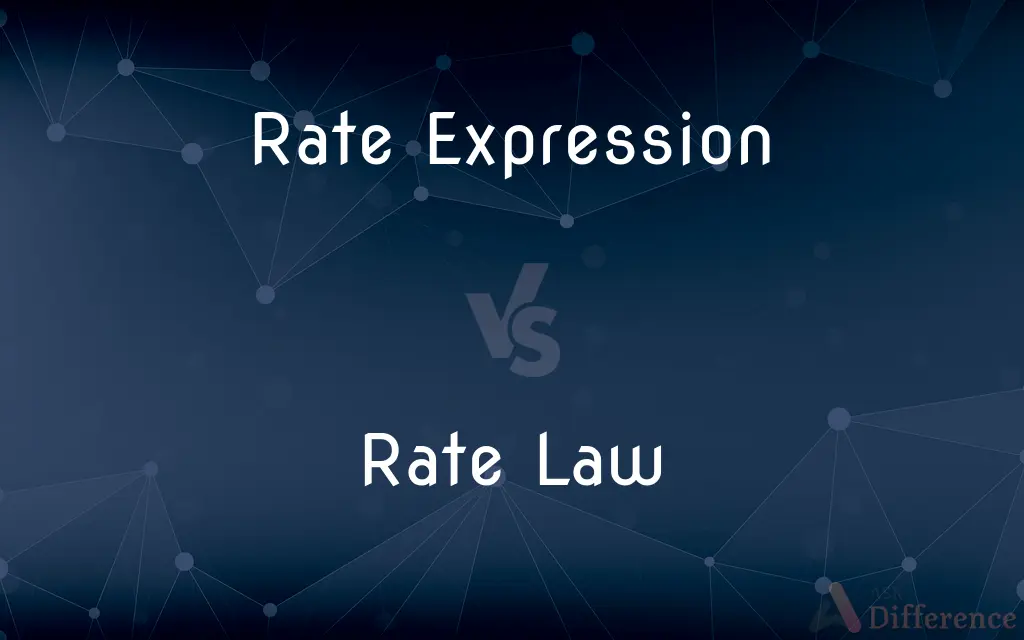Rate Expression vs. Rate Law — What's the Difference?
By Tayyaba Rehman & Maham Liaqat — Published on March 1, 2024
Rate expression generally refers to a formula showing how the rate of a reaction depends on the concentration of reactants, while rate law is a specific equation that quantifies this relationship, including constants and exponents for each reactant.

Difference Between Rate Expression and Rate Law
Table of Contents
ADVERTISEMENT
Key Differences
Rate expressions are broad representations of the relationship between the rate of a chemical reaction and the concentrations of reactants. These expressions are not necessarily derived from experimental data but rather indicate a general form based on stoichiometry or proposed mechanisms. Rate laws, however, are precise mathematical relationships determined experimentally, specifying how the rate depends on the concentration of reactants, including the rate constant and orders of reaction.
The formation of a rate expression often precedes the establishment of a rate law in the study of a reaction. Initially, a chemist might propose a rate expression based on the reaction mechanism, which is then refined through experiments to derive the accurate rate law that fits the observed data.
Rate laws include a rate constant (k), which is a proportionality constant unique to each reaction at a given temperature, and the exponents (the reaction orders) that indicate how the rate is affected by the concentration of each reactant. Rate expressions, in a more general sense, might not specify the value of the rate constant or the exact order of the reaction with respect to each reactant.
Experimentally determining a rate law involves measuring how changes in reactant concentrations affect the reaction rate. This can involve complex procedures and calculations to accurately identify the reaction orders and rate constant. In contrast, a rate expression might be hypothesized based on the balanced chemical equation or the mechanism without experimental verification.
The application of rate laws is crucial in chemical kinetics to predict the speed of reactions under various conditions, in designing reactors, and in understanding reaction mechanisms. Rate expressions serve as a preliminary step in these analyses, guiding the hypotheses and initial understanding before detailed studies are conducted.
ADVERTISEMENT
Comparison Chart
Definition
A general formula indicating the dependence of reaction rate on reactant concentrations.
A specific, experimentally determined equation quantifying the relationship between reaction rate and reactant concentrations.
Components
May suggest reactants’ influence on rate without specific constants or exponents.
Includes precise rate constants (k) and exponents indicating the order of reaction for each reactant.
Determination
Theoretically proposed based on reaction mechanism or stoichiometry.
Experimentally determined through kinetic studies.
Example Format
Rate ∝ [A][B] (suggestive, not experimentally verified)
Rate = k[A]^m[B]^n (where m and n are experimentally determined orders)
Application
Preliminary understanding of reaction kinetics; hypothesis formation.
Precise prediction of reaction rates; essential in chemical engineering and reaction mechanism analysis.
Specificity
General and broad.
Specific and detailed.
Experimental Basis
Not required.
Required for accurate determination.
Predictive Power
Limited, until further refined into a rate law.
High, allows for accurate prediction of reaction behavior under various conditions.
Compare with Definitions
Rate Expression
Guides initial understanding.
Rate expressions provide a starting point for investigating reaction kinetics.
Rate Law
Includes a specific rate constant.
The rate constant (k) in the rate law quantifies the reaction speed.
Rate Expression
A general formula indicating reactants’ effect on rate.
The rate expression for a reaction might start as Rate ∝ [A][B].
Rate Law
Essential for reaction prediction.
Rate laws are used to calculate how fast a reaction proceeds under specific conditions.
Rate Expression
Subject to refinement.
Through experiments, rate expressions are refined into precise rate laws.
Rate Law
Directly links kinetics to conditions.
The rate law allows chemists to predict the effects of concentration changes on reaction rate.
Rate Expression
Lacks specific constants and orders.
Rate expressions omit the rate constant and reaction orders before experimental determination.
Rate Law
An experimentally determined equation.
The rate law for a reaction might be Rate = k[A]^2[B].
Rate Expression
Not experimentally validated.
Initial rate expressions are hypotheses based on the chemical equation.
Rate Law
Specifies orders of reaction.
The exponents in a rate law indicate how rate changes with reactant concentration.
Common Curiosities
Why is the rate law important in chemical engineering?
In chemical engineering, the rate law is essential for designing reactors and processes, as it enables engineers to predict how changes in conditions (like concentration and temperature) will affect the speed of chemical reactions.
What does the rate constant in a rate law represent?
The rate constant (k) in a rate law represents the proportionality factor that relates the reaction rate to the concentrations of the reactants raised to their respective orders, specific to each reaction and temperature.
How is the order of reaction determined?
The order of reaction is determined experimentally by observing how the reaction rate changes with variations in reactant concentrations, often requiring multiple experiments under controlled conditions.
Does the rate law apply to all stages of a reaction?
The rate law typically applies to the rate-determining step of a reaction, which controls the overall rate. For complex reactions, multiple rate laws might describe different stages or mechanisms.
Can the rate law be predicted from the chemical equation?
The rate law cannot be directly predicted from the chemical equation; it must be determined through experimental observation, as it depends on the reaction mechanism, not just the stoichiometry.
How does temperature affect the rate law?
Temperature affects the rate constant (k) within the rate law, generally increasing the rate of reaction as temperature increases. This relationship can often be described by the Arrhenius equation.
What is the difference between the rate constant and the order of reaction?
The rate constant is a proportionality factor that quantifies the speed of the reaction at a given temperature, while the order of reaction describes how the reaction rate depends on the concentration of each reactant.
Can the rate law be used to determine reaction mechanisms?
Yes, the form of the rate law, including the reaction orders, can provide insights into the reaction mechanism, indicating which reactants and how many molecules are involved in the rate-determining step.
Are rate laws always linear?
No, rate laws can be nonlinear, especially in reactions where the order with respect to one or more reactants is not an integer, leading to complex kinetics.
How are rate laws used in environmental science?
Rate laws are used in environmental science to model the kinetics of pollution degradation, atmospheric reactions, and other processes critical to understanding and mitigating environmental impacts.
Share Your Discovery

Previous Comparison
Fat Soluble Vitamins vs. Water Soluble Vitamins
Next Comparison
Snowboard Jacket vs. Ski JacketAuthor Spotlight
Written by
Tayyaba RehmanTayyaba Rehman is a distinguished writer, currently serving as a primary contributor to askdifference.com. As a researcher in semantics and etymology, Tayyaba's passion for the complexity of languages and their distinctions has found a perfect home on the platform. Tayyaba delves into the intricacies of language, distinguishing between commonly confused words and phrases, thereby providing clarity for readers worldwide.
Co-written by
Maham Liaqat















































